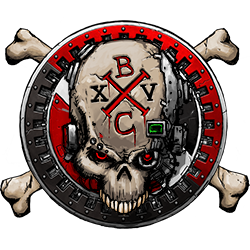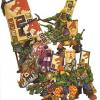Search the Community
Showing results for tags 'Shrineworld'.
-
For starters, the feudal shrineworld's background (skip it if you just want to see minis). Markings While most household troops go to war in their pristine uniforms, some (usually those who have seen regular combat) often don more battle-worthy armour and fatigues. Nevertheless, a unit’s battlefield role is indicated by coloured markings upon their armour and uniform in a manner akin to that of Arcadian regiments (c.f. the Arcadian 5th): Units fulfilling a command role such as company command squads display yellow markings. Units in a support role have blue markings. Examples include heavy weapon squads and dedicated transports. Assault units such as cavalry and many veteran units are marked with green. Infantry squads and other such line/tactical units are indicated by red markings. White indicates conscripts. Black indicates penitents. Infantry display these colours on hat bands, trouser stripes and epaulets (in the case of those wearing `soft` armour) or as a vertical stripe over the helmet and the front, back and lower side trim of shoulder pads (in the case of those wearing `hard` armour). Should an officer wear an aiguillette, the primary colour will be that of his unit type, with yellow or gold tips indicating his command position. Dual roles are indicated by combining two colours in these locations. This medic (white crescent trim) is assigned to a company command squad (yellow epaulets and hat band). Were he assigned to a platoon command squad he would have white trim on red epaulets. This veteran is a member of a company command squad, hence his yellow markings. This lieutenant commands a platoon command squad, hence his yellow hat band and the fact that his epaulets are yellow trimmed with red and his aiguillette is yellow tipped with red. Note that while platoons may include support and/or assault elements (heavy and special weapon squads) their colours are not indicated on the markings of the platoon command squad. This sergeant commands an infantry squad, hence his red hat band and the fact that his epaulets are red trimmed with yellow and his aiguillette is red tipped with yellow. This guardsman belongs to an infantry squad, hence his red markings. This sharpshooter belongs to a special weapons squad, hence his blue markings. His squad leader here too has a blue stripe and blue trim. As he is not a sergeant he lacks yellow markings (which would be a single yellow stripe along the top trim of the shoulder pads). This guardsman is a member of a veteran unit assigned to a close-assault role (tank-hunting, specifically) and so has green markings. Note that many veteran units dirty up their unit markings in the field to reduce their visibility. His sergeant: green trim and yellow command additions, weathered. This unit of homo sapiens variatus has a non-regulation standard in black, indicating their penitent status. Their custodian, a junior priest, has black trim upon his armour to indicate their role and his acceptance of leading the flock to their retribution. Ground vehicles primarily display these colours upon heraldic shields (mounted on the right side of any turret present), and occasionally other locations. This Medusa fulfills a support role and so its shield has a blue background. This is the shield of a Chimera transport assigned to a command squad, thus it displays both blue and yellow, with added red to reflect the squad’s role in commanding line units. The golden wreath indicates the high rank of the officer aboard. Additional markings One common marking seen upon infantry is a skull on the shoulder pad. This indicates a heroic action by the individual. It is coloured as per the individual’s role and/or unit type. The above image shows a master of ordnance’s shoulder armour, then that of a special weapon squad leader and a penitent squad custodian’s.
- 671 replies
-
- Kierdale
- Imperial Guard
-
(and 1 more)
Tagged with:


